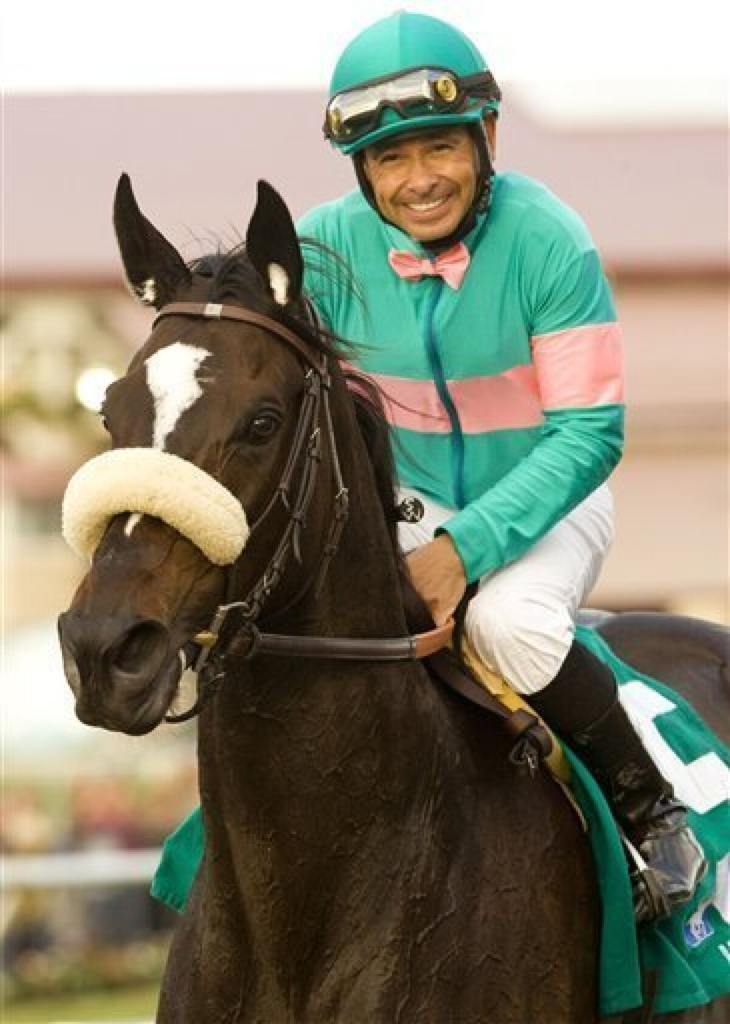
Forte on his way to a hard-earned victory in the Florida Derby (Coglianese)
By Laura Pugh
Speed figures are an amazing tool for handicappers to use. When used correctly, and in conjecture with other factors, it can lead one to some pretty great plays and predictions…
However, as helpful as they are, speed figures are not foolproof… and when it comes to some horses, almost completely useless. That is the case with Forte.
Most horses that have that “winning instinct” run their best unless specifically geared down. Others are a little trickier. They like a fight, and if they make the lead too soon, will pull themselves up, essentially waiting on horses. This sometimes even leads to those horses losing because they’d rather wait for their competitors. While figures can be difficult to quantify for these types, a handicapper can easily identify a “hanger” and choose to steer clear.
The third type of runner seems to come around much less often. These horses seem genuinely smart, exerting their full ability only when needed to, almost “target locking” on the lead horse, and doing what is necessary to pass them. Once they have secured the lead, they gear themselves down.
When horses fall into the third category, speed figures are almost meaningless. Unless the horse were to be challenged the entire length of the stretch or engaged for the vast majority of it, the figure would only reflect how fast the horse had to run, and not the true ability. Forte runs this way, as did another… Zenyatta.
Zenyatta was known for taking a while to get that long, gobbling stride uncoiled, but once she did, she’d lock on to the leader and would accelerate just enough to surge past. Sometimes in just the nick of time. In almost all of her races, just as she would pass, you’d see those big ears flip up, indicating that she knew she made the lead, and from that point, the measure of the field.
This nature of running led to her getting several very low speed figures. Her figures were often so low that during 2009, they were the main reason many Rachel Alexandra fans believed there was no way she would ever be able to catch the star three-year-old filly. Whether that is true or not, we’ll never know, however, it was still an ill-advised point to use, because Zenyatta only ever ran full out a couple of times.
The first was against a longshot in the 2009 Clement L. Hirsch Stakes, Annaba’s Creation. She got up in the shadow of the wire to win by a head. Due to the pace being slow, she was still awarded a slow figure. However, the second time was in her only loss, in the Breeders’ Cup Classic to Blame. She ran her hardest for the entirety of the Churchill Downs stretch and almost caught him. She ran a 111 Beyer Speed Figure that day, which was only one point lower than what she ran in the previous year’s edition of the Classic.
In both years, she was engaged for the majority of the stretch, received a fast pace to run into, and was against the strongest competitors she had ever faced. In 2009 She received a 112. In many of her other races, where the competition was far more inferior, and she often had soft paces in front of her, she would receive figures in the low to high 90s. But, as we can see, they were not even close to a true representation of her ability.
Forte runs in a very similar fashion. Yes, he in most cases, does race closer up than Zenyatta did. However, when watching his past performances he has flicked his ears up and geared himself down after hitting the front on all but two occasions. The Sanford Stakes, where for whatever reason, he failed to fire, and the Breeders’ Futurity. In the latter, the runner-up Loggins kept him engaged the entire length of the stretch.
Beyer gave him a 92 rating in that race while TimeformUS rated him a 115. From what their creator, Craig Milkowski has said, one can guestimate the Beyer Figure by subtracting 20 from his figure. In the Breeders’ Cup Juvenile, he received a Beyer Figure of 102 and a TimeformUS of 117. This would indicate that Milkowski did not see the big jump that Beyer did.
In 2023, thus far, Forte has earned a 98 and 95 BSF in the Fountain of Youth and the Florida Derby. On the TimeformUS scale, he’s earned a 118 and 115, respectively. These figures, taken at face value would indicate that Forte has not improved from age two to three. To stop at that assumption would be a mistake.
In the Fountain of Youth, Forte was reserved for nearly the entire race. He made his move coming around the final turn, and once he straightened away, he opened up nearly four lengths in just a few seconds. The ears went up and he cruised through the majority of the stretch. In the Florida Derby, he began to make his run around the far turn again but got stopped when he ran into traffic, which halted his momentum. By the time he finally leveled off, there was a little more than 1/16th of a mile left, and in that time he went from two lengths behind to one in front. It’s worth noting, that his ears went up again, after gaining the lead by about ½ a length.
In neither race did we get to see just how much Forte had. In both races, he only exerted himself for an 1/8th of a mile or less, which gives us very little indication of his true ability. Forte, like Zenyatta, locks on to the lead horse, and only exerts for as long as it takes to make the front. After that, he eases up.
So, if you are wondering why his figures look so low, despite impressive performances visually, this is definitely something you will want to consider. Speed figures won’t mean much use when it comes to him… not until he comes across a scenario that forces him to exert for the majority of the stretch.




